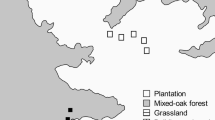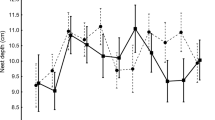Summary
Laying data and clutch size of Great Tits were studied in four different habitats in eastern Spain: two holm oak(Quercus ilex) forests, at 500 and 900–950 m a.s.l., a zeen oak(Quercus faginea) forest, at 900–1100 m a.s.l., a pine(Pinus sylvestris) forest, at 1000–1050 m a.s.l., and orange(Citrus aurantium) plantations, at 30 m a.s.l. All sites were placed at about the same latitude (39–41°N), and all were studied during the same years (1992–95). Our results show that (1) laying date did not differ between the natural habitats at the same altitude (range of the means of yearly means 4–8 May); (2) within the same habitat type (holm oak forest) laying date was earlier at low altitude (30 Aprilvs. 8 May); (3) laying date was earlier in the orange plantations (21 April) than in natural habitats; (4) among natural habitats at the same altitude, clutch size decreased from zeen oak (mean of yearly means 7.3 eggs) to holm oak (7.0 eggs) to pine forests (6.4 eggs), though only the difference between zeen oak and pine forests was significant; (5) within the same habitat type (holm oak forest), the clutch size tended to be larger at high altitude (7.0vs. 5.9 eggs); and (6) clutch size in orange plantations (7.7 eggs) did not differ significantly from that of the zeen oak forest, but was larger than in the holm oak and pine forests. We discuss the effect of the habitat type on laying date and clutch size of Great Tits.
Zusammenfassung
Legedatum und Gelegegröße der Kohlmeise wurden in vier unterschiedlichen Biotopen in Ostspanien untersucht: zwei Steineichenwälder(Quercus ilex) in 500 m und 900–950 mNN, ein Bergeichenwald(Quercus faginea) in 900–1100 mNN, ein Kiefernwald(Pinus sylvestris) in 1000–1050 mNN und eine Orangenpflanzung(Citrus aurantium) in 30 mNN. Alle fünf Gebiete lagen auf etwa demselben Breitengrad (39–41°N) und wurden 1992–1995 parallel untersucht.
(1) Auf gleicher Meereshöhe unterscheidet sich der Legebeginn nicht zwischen den verschiedenen Waldbiotopen (im Mittel 4.–8. Mai). (2) Innerhalb desselben Biotoptyps (Steineichenwald) war der Legebeginn auf niedrigerer Meereshöhe früher als in höheren Lagen (30. April vs. 8. Mai). (3) Im Orangenhain wurde früher mit der Eiablage begonnen (21. April) als in den Waldbiotopen. (4) Auf gleicher Meereshöhe nahm die Gelegegröße vom Bergeichenwald (Mittelwert 7.3 Eier) über die Steineichenwälder (7,0 Eier) zum Kiefernwald hin ab (6.4 Eier), jedoch ist nur der Unterschied zwischen Bergeichenwald und Kiefernwald signifikant. (5) Innerhalb der Steineichenwälder besteht die Tendenz zu größerer Gelegegröße in den höheren Lagen (7.0 vs. 5.9 Eier). (6) Im Orangenhain war die Gelegegröße mit durchschnittlich 7.7 Eier ähnlich der im Bergeichenwald, aber größer als in den Steineichen- und Kiefernwälder.
Similar content being viewed by others
References
Banbura, J., Blondel, J., de Wilde-Lambrechts, H., Galan, M.-J. & Maistre, M. (1994): Nestling diet variation in an insular Mediterranean population of blue titsParus caeruleus: effects of years, territories and individuals. Oecologia 100: 413–420.
Baouab, R.E., Thévenot, M. & Aguesse, P. (1986): Dynamique des populations de la Mésange bleueParus caeruleus en chênaies de Mamora et du Moyen Atlas. Bull. Inst. Sci. Rabat 10: 165–183.
Barba, E. & Gil-Delgado, J.A. (1990): Seasonal variation in nestling diet of the Great TitParus major in orange groves in eastern Spain. Ornis Scand. 21: 296–298.
Barba, E., García, D.M., Gil-Delgado, J.A. & López, G.M. (1994): Moth abundance and breeding success in a Great Tit population where moths are the main nestling food. Ardea 82: 329–334.
Barba, E., Gil-Delgado, J.A. & Monrós, J.S. (1995): The costs of being late: consequences of delaying great titParus major first clutches. J. Anim. Ecol. 64: 642–651.
Belda, E.J. (1996): Estrategias de vida del carbonero comúnParus major y del herrerillo comúnParus caeruleus en el área mediterránea. Tesis Doctoral, Universidad de Valencia.
Blondel, J., Clamens, A., Cramm, P., Gaubert, H. & Isenmann, P. (1987): Population studies on tits in the Mediterranean region. Ardea 75: 21–34.
Blondel, J., Dias, P.C., Maistre, M. & Perret, P. (1993): Habitat heterogeneity and life-history variation of Mediterranean Blue Tits(Parus caeruleus). Auk 110: 511–520.
Blondel, J., Isenmann, P., Maistre, M. & Perret, P. (1992): What are the consequences of being a downy oak(Quercus pubescens) or a holm oak(Q. ilex) for breeding blue tits(Parus caeruleus)? Vegetatio 99–100: 129–136.
Bussotti, F. & Grossoni, P. (1997): European and Mediterranean oaks (Quercus L.; Fagaceae):SEM characterization of the micromorphology of the abaxial leaf surface. Bot. J. Linn. Soc. 124: 183–199.
Chabi, Y. & Isenmann, P. (1997): La reproduction de la Mésange BleueParus caeruleus ultramarinus dans des subéraiesQuercus suber à trois différentes altitudes en Algérie. Alauda 65: 13–18.
Chabi, Y., Isenmann, P., Benyacoub, S. & Samraoui, B. (1995): Breeding ecology of the North-African Blue Tit(Parus caeruleus ultramarinus) in two semi-evergreen oak forests in Algeria. Rev. Ecol. (Terre Vie) 50: 133–140.
Clamens, A. & Martin, J.L. (1991): Laying date in Mediterranean Blue Tits: effect of habitat type and geographic isolation. Ornis Scand. 22: 401–403.
Clouet, M. (1996): Variation de la ponte des mésanges et altitude dans les Pyrénées. Alauda 64: 159–164.
Cowie, R.J. & Hinsley, S.A. (1987): Breeding success of Blue Tits and Great Tits in suburban gardens. Ardea 75: 81–90.
Cramp, S. & Perrins, C.M. (eds.) (1993): The birds of the western Palearctic. Vol. VII. Oxford.
Dhondt, A.A., Adriansen, A., Matthysen, E. & Kempenaers, B. (1990): Nonadaptive clutch sizes in tits: evidence for the gene flow hypothesis. Nature 348: 723–725.
Dhondt, A.A., Eyckerman, R., Moermans, R. & Hublé, J. (1984): Habitat and laying date of Great and Blue TitParus major andP. caeruleus. Ibis 126: 388–397.
Gibb, J. & Betts, M.M. (1963): Food and food supply of nestling tits (Paridae) in Breckland pine. J. Anim. Ecol. 32: 489–533.
Gil-Delgado, J.A., Pardo, R., Bellot, J. & Lucas, I. (1979): Avifauna del naranjal valenciano. II. El Gorrión Común (Passer domesticus L.). Mediterránea Ser. Biol. 3: 69–99.
Gil-Delgado, J.A., López, G.M. & Barba, E. (1992): Breeding ecology of the blue titParus caeruleus in eastern Spain: a comparison with other localities with special reference to Corsica. Ornis Scand. 23: 444–450.
Hamann, H.J., Schmidt, K.-H. & Simonis, S. (1989): Der Einfluß der Höhenlage auf Ei- und Gelegegröße bei Kohlmeisen(Parus major). J. Ornithol. 130: 69–74.
Hansson, S., Hobbie, J.E., Elmgren, R., Larsson, U., Fry, B. & Johansson, S. (1997): The stable nitrogen isotope ratio as a marker of food-web interactions and fish migration. Ecology 78: 2249–2257.
Iglesias, D.J. (1996): Efecto de la abundancia de alimento sobre los parámetros reproductores de los páridos en un encinar mediterráneo. Tesis Doctoral, Universidad de Valencia.
Isenmann, P. (1987): Geographical variation in clutch size: the example of the Blue TitParus caeruleus in the Mediterranean area. Vogelwarte 34: 93–99.
Lambrechts, M.M., Blondel, J., Hurtrez-Bouses, S., Maistre, M. & Perret, P. (1997): Adaptive inter-population differences in blue tit life-history traits on Corsica. Evol. Ecol. 11: 599–612.
Lambrechts, M.M. & Dias, P.C. (1993): Differences in the onset of laying between island and mainland Mediterranean Blue TitsParus caeruleus: phenotypic plasticity or genetic differences? Ibis 135: 451–455.
Lemel, J. (1989): Habitat distribution in the Great Tit Parus major in relation to reproductive success, dominance and biometry. Ornis Scand. 20: 226–233.
López, G.M. (1991): Intervención de la fauna en el ciclo de nutrientes de un encinar mediterráneo. Tesis Doctoral, Universidad de Alicante.
Maicas, R. & Fernández, J. (1996): Breeding patterns of the Great Tit(Parus major) in a pine plantation and a holm oak forest in a Mediterranean region (southern Spain). Rev. Ecol. (Terre et Vie) 51: 341–357.
Majoral, R., Pérez, J. & Salvà, P. (1993): L'Agricultura i la Ramaderia. Geografia General dels Països Catalans: 163–268. Barcelona.
Monrós, J.S., Lacort, P., Iglesias, D.J. & Gil-Delgado, J.A. (1997): Nestling diet of Coal Tits(Parus ater) and Great Tits(P. major) in a pine forest(Pinus sylvestris) of eastern Spain. Ardeola 44: 239–241.
Muller, Y. (1985): Etude comparée de la reproduction de la Mésange charbonnière(Parus major) dans trois formations forestières des Vosges du Nord. Ciconia 9: 1–21.
Perrins, C.M. (1979): British tits. London.
Perrins, C.M. (1990): Concluding remarks: dispersal and gene flow. In: Blondel, J., Gosler, A.G., Lebreton, J.-D. & McCleery, R.H. (eds): Population biology of passerine birds: An integrated approach: 475–480. Berlin.
Perrins, C.M. (1991): Tits and their caterpillar food supply. Ibis 133 suppl. 1: 49–54.
Perrins, C.M. & McCleery, R.H. (1989): Laying dates and clutch size in the Great Tit. Wilson Bull. 101: 236–253.
Pikula, J. (1975): Gelegegröße und Brutbeginn beiParus major undParus ater im Bergmassiv Belanské Tatry. Zool. Listy 24: 373–384.
Sanz, J.J. (1997): Geographic variation in breeding parameters of the Pied FlycatcherFicedula hypoleuca. Ibis 139: 107–114.
Schmidt, K.-H. & Steinbach, J. (1983): Niedriger Bruterfolg der Kohlmeise(Parus major) in städtischen Parks und Friedhöfen. J. Ornithol. 124: 81–83.
SPSS Inc. (1994): SPSS/PC+ para Windows. Versión 6.0.1. Chicago.
Van Balen, J.H. (1973): A comparative study of the breeding ecology of the Great Tit(Parus major) in different habitats. Ardea 61: 1–93.
Van Balen, J.H. & Potting, P.J. (1990): Comparative reproductive biology of four Blue Tit populations in The Netherlands. In: Blondel, J., Gosler, A.G., Lebreton, J.-D. & McCleery, R.H. (eds): Population biology of passerine birds: An integrated approach: 19–38. Berlin.
Zandt, H.G., Strijkstra, A.M., Blondel, J. & Van Balen, J.H. (1990): Two Mediterranean blue tit populations: Are differences in the timing of breeding associated with caterpillar availability? In: Blondel, J., Gosler, A. G., Lebreton, J.-D. & McCleery, R.H. (eds): Population biology of passerine birds: An integrated approach: 145–155. Berlin.
Zang, V.H. (1980): Der Einfluß der Höhenlage auf Siedlungsdichte und Brutbiologie höhlenbrütender Singvögel im Harz. J. Ornithol. 121: 371–386.
Zang, V.H. (1982): Der Einfluß der Höhenlage auf Alterszusammensetzung und Brutbiologie bei Kohl- und Blaumeise(Parus major, P. caeruleus) im Harz. J. Ornithol. 123: 145–154.
Zar, J.H. (1996): Biostatistical Analysis. 3rd. ed. Upper Saddle River, NJ.
Zaragoza, S. (1988): Pasado y presente de la citricultura española. Serie Divulgación Técnica no. 8. Valencia.
Author information
Authors and Affiliations
Corresponding author
Rights and permissions
About this article
Cite this article
Beldal, E.J., Barba, E., Gil-Delgado, J.A. et al. Laying date and clutch size of Great Tits(Parus major) in the Mediterranean region: a comparison of four habitat types. J Ornithol 139, 269–276 (1998). https://doi.org/10.1007/BF01653337
Accepted:
Published:
Issue Date:
DOI: https://doi.org/10.1007/BF01653337




